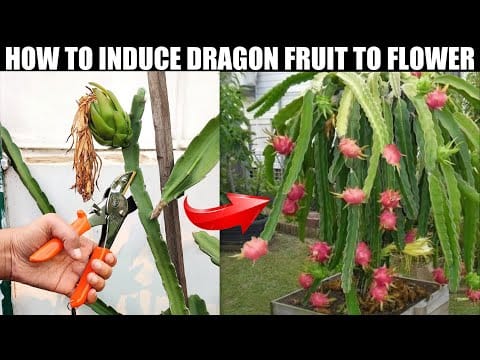Dragon fruit, or pitaya, is a unique and delicious tropical fruit that many people enjoy. It is also an attractive plant with its brightly colored flowers. However, in order to get dragon fruit to flower, there are a few steps that need to be taken. In this article, we will discuss how to get dragon fruit to flower so that you can enjoy its beauty as well as its delicious fruit. We will cover topics such as the proper growing conditions for dragon fruit and the necessary care for it to bloom. With the right knowledge and care, you can have a thriving dragon fruit plant in your garden that produces beautiful flowers and tasty fruits.In order to get dragon fruit to flower, it is important to provide the plant with adequate warmth and sunlight. Make sure the plant receives at least four hours of direct sunlight per day, preferably in the morning. The dragon fruit plant also requires temperatures between 70-80°F (21-27°C). Additionally, watering the plant regularly can help encourage flowering. While it can be tempting to over-water, make sure not to use too much water as this could lead to root rot. Lastly, fertilizing the dragon fruit with a high phosphorus fertilizer every three months can also help promote flowering.
Preparing the Soil for Dragon Fruit Plant
Dragon fruit plants require well-drained soil with a pH range of 6.0 to 7.5. The ideal soil type is sandy or loamy, and it should be light and airy. If you have heavy clay or rocky soil, you will need to amend it with organic matter such as compost or manure. Before planting, it is important to work in plenty of organic matter into the soil to increase its fertility and drainage capacity. Additionally, if your soil is particularly acidic or alkaline, you can adjust the pH by adding lime or sulfur as needed.
It is also recommended that you till the soil a few inches deep before planting dragon fruit plants. This will help improve drainage and aeration of the soil and make it easier for roots to penetrate and grow. If your soil is compacted, you may want to add some sand so that water can move through more quickly. Finally, make sure that any weeds or debris are cleared out before planting your dragon fruit plants.
Choosing the Right Planting Site
When it comes to planting, choosing the right site is essential for successful growth. A well-chosen site will provide the right level of light, water, and soil nutrition for your chosen plants. Factors such as soil pH and texture, adequate drainage, and climate all play a role in determining the best planting site.
When selecting a planting site, consider factors like sunlight exposure. Different plants require different amounts of light to thrive. If you are growing vegetables or herbs, look for a site that receives at least six hours of direct sunlight per day during peak growing season. For other plants, such as shrubs or trees, make sure that the site is not too shady or too sunny.
Water is essential to plant health and should be taken into account when selecting a planting site. Look for areas where there is adequate drainage to avoid waterlogging roots. If you are planning to irrigate your plants regularly, make sure there is easy access to a water source.
The type of soil in your chosen planting area can also influence your success rate with certain plants. Make sure you assess the soil’s pH level and texture before you begin planting so that it will support the type of plants you are growing. If necessary, add amendments such as compost or mulch to improve soil quality.
Climate also plays an important role when choosing a planting area; some plants thrive in hot climates while others do better in cooler regions. When selecting a site for your garden or landscape project, research what type of climate would be best suited for the specific types of plants you plan on growing.
By taking all these factors into consideration when choosing a planting site, you will have a greater chance of success with your garden or landscape project!
Watering Dragon Fruit Plant
Proper watering is essential for the health of a dragon fruit plant. Water the plant deeply and thoroughly, allowing the soil to become slightly moist. Try to water the dragon fruit plant in the morning, as this will give it enough time to absorb the water. Allow the top inch or two of soil to dry out before watering it again. Avoid over-watering, as this can lead to root rot and other problems. If the leaves start turning yellow or wilting, it may indicate that you are over-watering your plant.
Fertilizing Dragon Fruit Plant
Dragon fruit plants need fertilizer for proper growth and development. Use a balanced fertilizer with an equal amount of nitrogen, phosphorus, and potassium once every month during the growing season (from spring to fall). Avoid using too much fertilizer as this can burn or damage your dragon fruit plant. Also, don’t fertilize during winter months when your dragon fruit plant is dormant. It’s best to use organic fertilizers such as compost or manure for maximum benefit.
Pruning Techniques for Dragon Fruit Plant
Pruning is an important part of the cultivation of dragon fruit plants. It helps to maintain the health and shape of the plant, as well as encourages new growth and blossoms. Pruning can also help to control the size and spread of the plant, making it easier to care for. When pruning a dragon fruit plant, there are a few key techniques that should be used.
One technique is called “tip pruning”. This involves cutting off any tips or branches that are growing too long or at an angle. This will help to keep the plant in its desired shape and create more room for new blossoms to form. It is important to make sure not to cut too much off at once, as this could damage the plant.
Another technique is “deadheading” which involves removing any dead or dying flowers from the plant. Deadheading helps promote new growth by removing any obstructions that might be preventing new blossoms from forming. It also helps keep the plants looking attractive and healthy.
The last technique is “thinning”, which involves removing any overcrowded branches or stems that may be competing for resources with other parts of the plant. This can help create a more even distribution of resources throughout the entire plant, so it can grow more efficiently and produce better fruit yields.
These are just some of the pruning techniques used when cultivating dragon fruit plants. When done properly, they can help ensure that your plants remain healthy and productive for years to come.

Understanding the Flowering Cycle of Dragon Fruit Plant
Dragon fruit, also known as pitaya, is a tropical fruit that is popular for its unique look and sweet flavor. It is native to Mexico, Central America, and South America, but it has been cultivated in many parts of the world. To produce a successful crop of dragon fruit, it is important to understand its flowering cycle.
The flowering cycle of a dragon fruit plant typically starts in late spring or early summer. The flowers are usually white with pink stripes and open at night. They are pollinated by night-flying insects such as moths and bats, and can remain open for several days if the weather remains favorable. Once pollination has occurred, the flowers will begin to wilt and drop off within a few days.
After pollination has occurred, it usually takes between four to six weeks for the fruit to develop fully. During this time, the plant will produce small green fruits that gradually increase in size as they ripen. Depending on the variety of dragon fruit plant being grown, the fruits may be ready to harvest after four weeks or they may take up to six weeks before they are ready for picking.
When harvesting dragon fruit, it is important that you wait until they are fully ripe before picking them off the vine. Overripe fruits will have soft spots on their skin and may have begun to split open at their stem ends. If you pick them too early they won’t have developed their full flavor and sweetness yet so it’s best to wait until they are ripe before harvesting them.
Understanding the flowering cycle of dragon fruit plants is essential for producing a successful crop each year. Knowing when to expect flowers and when to harvest your fruits can help ensure that you get maximum yield from your plants each season. With proper care and attention, you can enjoy delicious dragon fruit from your own garden every year!
Ensuring Adequate Sunlight for Dragon Fruit Plant
Dragon fruit plants, scientifically known as Hylocereus undatus, require a warm climate with plenty of sunlight. As such, they need full sun exposure of at least 6-8 hours a day for optimal growth and flowering. To ensure an adequate amount of sunlight, it is important to place the dragon fruit plant in an area that receives direct sunlight for most of the day. This is especially important during the early stages of development when the plant is establishing its root system. If possible, it is best to provide supplemental lighting during periods when there is not enough natural sunlight available.
When selecting a location for the dragon fruit plant, consider aspects such as wind and temperature. Windy conditions can dry out soil quickly and stunt growth, while cooler temperatures can slow down flowering and reduce yields. It is also important to ensure that the plant has enough space to grow without being crowded by other plants or structures. If there are any nearby trees or buildings that can cast shadows on the dragon fruit plant, it may be necessary to move it to another area with more direct sunlight.
In addition to providing adequate sunlight for your dragon fruit plant, you should also take steps to protect it from frost and extreme temperatures. In areas where frost occurs regularly, it may be necessary to cover or move the plant indoors until temperatures become more favorable. When temperatures reach over 100°F (38°C), provide shade and extra water for your dragon fruit plant so that it does not become stressed or damaged by the heat. With proper care and attention, your dragon fruit plant will thrive and produce an abundance of delicious fruits!
Controlling Insects and Diseases for Healthy Flowering of Dragon Fruit Plant
Dragon fruits are a popular and nutritious fruit that can be grown in home gardens. It is important to take care of the dragon fruit plant to ensure healthy flowering. One way to do this is to control insects and diseases. Proper insect control is essential for dragon fruit plants, as they are susceptible to a variety of pests. The most common pests include aphids, mealybugs, whiteflies, scale insects, caterpillars, mites, and thrips. These pests can cause damage to the plant by sucking sap from the leaves or stems, which can lead to wilting or stunted growth. To prevent this from happening, it is important to regularly inspect plants for signs of pests and take measures to control them. This can involve using chemical sprays or physical barriers such as screens or sticky traps.
Disease prevention is also important for maintaining healthy dragon fruit plants. Common diseases that affect dragon fruits include root rot, powdery mildew, and fungal infections. These diseases can spread quickly through the plant if not treated promptly. To prevent disease outbreaks it is important to keep the garden clean by removing any dead foliage or debris and keeping the soil well-drained and aerated. Regularly inspecting plants for signs of disease can help catch any problems early on so that they can be treated quickly. Additionally, spraying the plant with fungicides may help reduce the spread of fungal infections.
By controlling both insects and diseases on dragon fruit plants you can ensure healthy flowering and fruiting of these delicious fruits! Taking regular preventive measures such as inspecting plants for signs of pests or disease and taking steps to control them will help keep your dragon fruit plants thriving!

Conclusion
Dragon fruit can be a difficult crop to cultivate, but with the right conditions and care, you can achieve success. You must provide your dragon fruit with adequate light, warmth, water, and nutrients in order to encourage flowering. Additionally, pruning the vines and providing pollinating insects access to the flowers will help ensure successful pollination. With patience and dedication, you should be able to enjoy the sweet fruits of your labor.
To recap:
• Ensure that your dragon fruit plants are receiving adequate light, warmth, water, and nutrients
• Prune the vines regularly to help encourage flowering
• Provide access for pollinating insects
• Be patient and don’t rush the process
By following these steps carefully and consistently, you can successfully get your dragon fruit plants to flower so that you can enjoy their delicious fruits!



